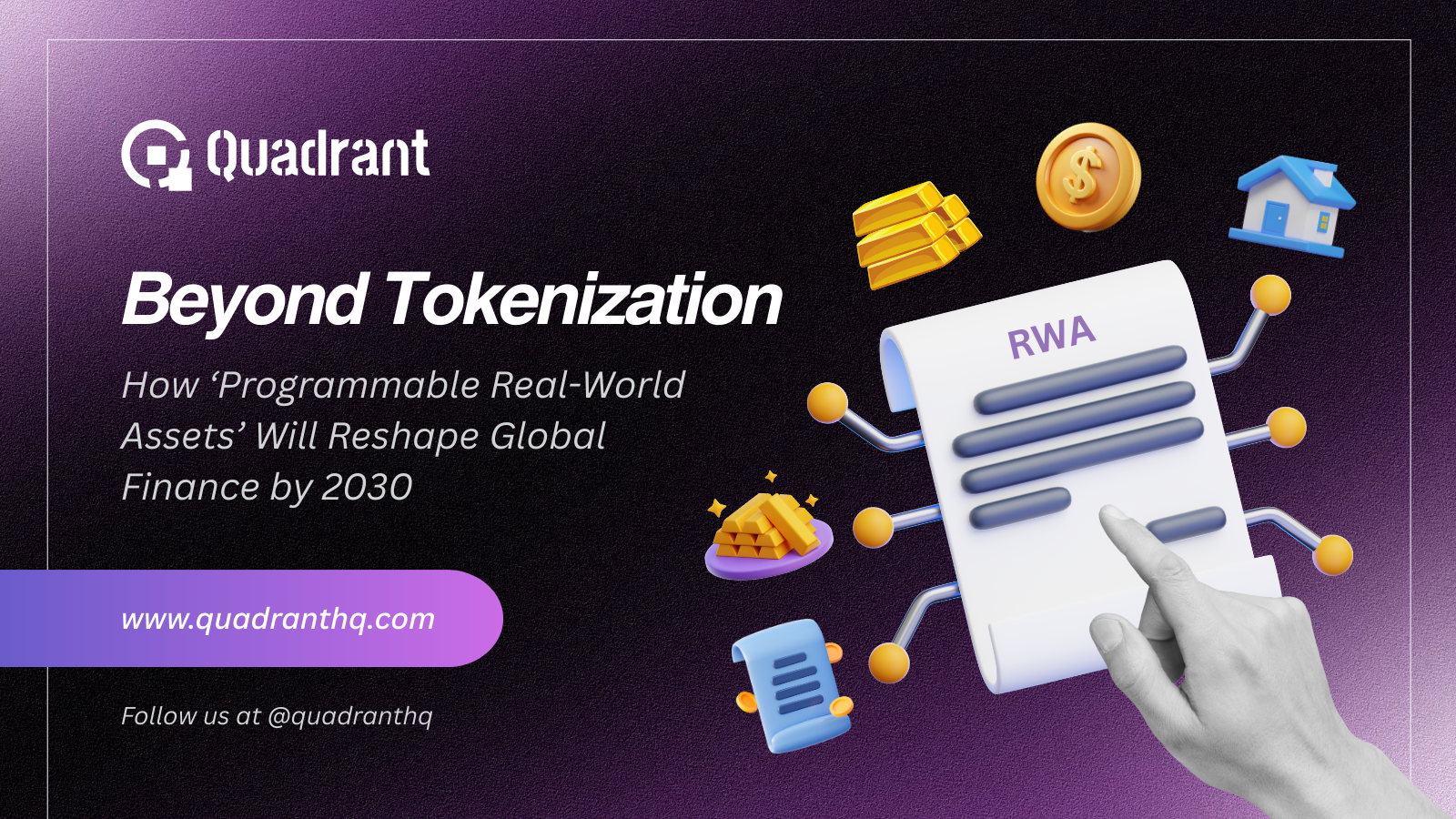
Beyond Tokenization: How ‘Programmable Real-World Assets’ Will Reshape Global Finance by 2030
Real-world assets (RWAs) have already become one of the fastest-growing segments in the blockchain ecosystem, but the next leap is far more transformative than simple tokenization. By 2030, RWAs are projected to evolve into programmable, intelligent, and autonomous financial instruments capable of enforcing compliance, distributing yield, and managing risk without human intervention. This shift marks the beginning of a new programmable financial layer, where assets behave like software, and global markets operate with unprecedented efficiency.
In this evolution, platforms like Quadrant are emerging as the backbone of programmable RWA infrastructure, bringing structure, trust, and automation to an ecosystem poised for exponential growth.
The Rise of Programmable RWAs: From Static Tokens to Smart Assets
Tokenization, in its early form, simply mirrored offline assets onto the blockchain. A bond became a token. A property became a digital certificate. While this enabled fractionalization and liquidity, the tokens themselves remained passive representations.
Programmable RWAs change everything.
These next-generation assets integrate logic at the protocol layer. They are dynamic, event-responsive, and capable of executing contractual conditions programmatically. Think of them as “smart assets” embedded with rules and behaviors that self-operate within financial systems.
This programmability allows RWAs to:
- Adapt in real-time based on market or legal triggers
- Interact with other on-chain systems like oracles, risk engines, or lending markets
- Execute functions automatically without intermediaries
By 2030, programmable RWAs will power markets where execution isn’t just faster, but also autonomous.
Real-Time Compliance: Law Built Into the Ledger
One of the biggest limitations of traditional finance is compliance friction. Manual audits, cross-border verification, and siloed data slow everything down.
Programmable RWAs embed compliance logic directly into their structure.
Imagine an asset that:
- Prevents transfers to non-KYC’d wallets
- Auto-enforces jurisdictional restrictions
- Updates credit or risk status via real-time oracle feeds
- Ensures regulatory reporting happens autonomously
This turns compliance into an always-on, self-updating layer, reducing both cost and risk for institutions.
Quadrant’s framework plays a crucial role here by enabling institutions to encode rulesets, permissions, and regulatory constraints directly into the asset at the structural level, ensuring trust without sacrificing composability.
Automated Yield Distribution: Income Streams Without Intermediaries
Income-generating assets like invoice pools, treasury bills, corporate debt, or real-estate yields will soon distribute returns automatically.
Through smart contracts, programmable RWAs can:
- Calculate yields in real time
- Adjust distributions based on market conditions
- Route earnings instantly to investor wallets
- Create dynamic interest models tied to protocols or risk models
Instead of waiting weeks or months for reconciliation, investors could receive yield block-by-block.
Quadrant enhances this by providing programmable modules that define payout logic while ensuring transparency, traceability, and compliance in every distribution cycle.
Smart-Contract–Driven Liquidation: Automated Risk Management
Risk management will undergo a fundamental shift with autonomous liquidation rules.
Programmable RWAs can embed:
- Automated collateral calls
- Real-time valuation updates
- Trigger-based liquidation thresholds
- Fail-safe execution pathways
If market prices fall or collateral ratios shift, the asset can self-liquidate according to predefined rules, minimizing counterparty risk and improving systemic stability.
Quadrant’s asset structuring layer can integrate Oracle feeds, credit scoring engines, and liquidity rules so liquidations are not only automated but verifiably fair and transparent.
Quadrant’s Role: The Infrastructure for Programmable Asset Structures
Quadrant isn’t just enabling RWA tokenization, it’s laying the foundation for fully programmable, institution-grade financial assets.
Quadrant empowers issuers and institutions by offering:
- Programmable asset blueprints for bonds, loans, invoices, and more
- Compliance-first logic modules embedded directly into on-chain structures
- Interoperability across chains, wallets, and custodians
- Auditable transparency through structured metadata and standardized asset models
By abstracting complexity, Quadrant makes it possible for institutions to deploy programmable RWAs at scale securely, efficiently, and in compliance with global regulations.
The Future: A Financial System That Runs on Code
By 2030, global markets will operate on programmable rails.
- Assets won’t just exist; they will think, react, and self-govern.
- Compliance will become an automated utility layer.
- Risk will be managed in real time.
- Yield will be streamed continuously.
- Settlement will be instant and trustless.
Programmable RWAs represent the next major evolution of digital finance, one where financial logic becomes embedded into the assets themselves.
With pioneers like Quadrant building the underlying programmable infrastructure, this future isn’t far away. It’s already taking shape.